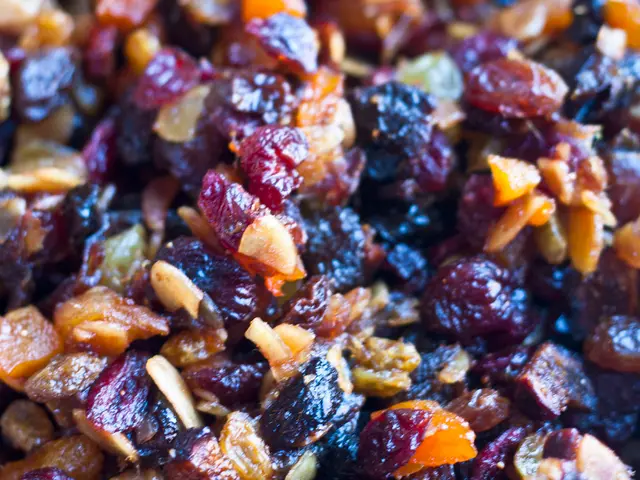Gearing Up for a Promising Honey Harvest in Hesse's Blossoming Landscape
Hesse-based beekeepers anticipate a successful initial honey collection. - Anticipating Successful Initial Honey Harvest in Hesse (Among Beekeepers)
руководство
Beekeepers in the breathtaking region of Hesse are anticipating a fruitful first honey harvest this spring, following a relatively mild winter that left some bee colonies shattered. Christian Schirk, the spokesperson for the Hessian Beekeepers' Association, shares their optimistic outlook.
"The bees have been flying almost non-stop, taking advantage of the plentiful blossoms," he said. Despite the occasional drought, crucial plants like willows, maples, and fruit trees still managed enough moisture for nectar production. "The scarcity of rain has actually helped facilitate colony growth in the final few weeks and months, and a great to fantastic first yield is predicted."
The season of swarming is now upon us. "Honey harvests are underway, and the queen-rearing season has just commenced," said Schirk. The start of the swarming season is often signaled by the onset of the rape blossom - in North Hesse this year in mid-April, and earlier in the south.
The mild winters that contribute to the proliferation of the Varroa mite are thought to be the primary reason for the high winter casualties. "There was scarcely a brood break - that leaves colonies vulnerable," they said. In nature, a bee colony would not stand a chance of survival today.
However, the future developments of the season cause some concern. If the rain continues to evade the landscape, plants like blackberries or lindens may not make significant contributions to the honey yield.
Beekeepers are noticing a discernible shift in blossoming patterns and increasing weather extremes - a trend they believe is persisting. Normally, two to three harvests can be made per year, but it remains uncertain whether this pattern will continue into 2023.
- Hesse
- Yield
- Bees
- Spring
- Plants
- Kirchhain
- Bee colony### Exploring the Factors Behind the Expected Yields
Thriving first honey harvest in Hesse's renowned landscapes this spring is contingent upon a multitude of factors, including weather patterns, plant forage, and the impact of Varroa mites. Here's a closer look at these influences:
Expected Yields
The first honey harvests typically occur in late spring or early summer, depending on the abundance of nectar from various blooms. In Hesse, the timing can fluctuate based on weather conditions and the availability of nectar-rich plants like apple blossoms, rape, and sunflowers.
Weather Patterns
Weather plays an indispensable role in the success of honey bee colonies. Favorable weather conditions, such as mild winters followed by warm springs with sufficient rainfall, can amplify nectar flows and boost honey production. In contrast, extreme weather events such as droughts or cold spells can restrict nectar availability and impair colony health.
Plant Forage
Plant forage is another vital consideration. Hesse's diverse flora offers a wealth of nectar sources for bees. However, the quantity and seasonality of these plants can vary from year to year. Early-spring plants like apple blossoms and later crops like sunflowers are crucial for sustaining strong nectar flows.
Varroa Mites
Varroa mites pose a significant threat to honey bee colonies around the globe, including in Hesse. These parasites debilitate bees, making them more vulnerable to diseases and limiting their capacity to forage effectively. Controlling Varroa mite infestations through comprehensive pest management techniques is essential for fostering healthy colonies and ensuring successful harvests.
To tackle these challenges, beekeepers in Hesse employ various methods, including monitoring weather forecasts, maintaining diverse foraging areas, and implementing rigorous Varroa mite control measures. These strategies can help enhance honey production and safeguard the future of local bee populations.
Despite the uncertainty regarding the exact harvest dates and yields for honey bees in Hesse this spring, understanding these factors can aid in predicting and preparing for the upcoming harvest season.
Beekeepers in Hesse anticipate a great to fantastic first honey yield this spring, primarily due to the mild winter and plentiful plant forage. Christian Schirk, the spokesperson for the Hessian Beekeepers' Association, highlights that the bees have been taking advantage of the blossoming plants and a significant nectar production.
The increasing awareness about the impacts of Varroa mites on honey bee colonies has led Hesse beekeepers to employ rigorous pest management techniques to control these parasites and ensure the health and success of their colonies. Monitoring weather forecasts, maintaining diverse foraging areas, and implementing comprehensive Varroa mite control measures can help enhance honey production and safeguard the future of local bee populations.





